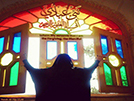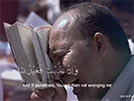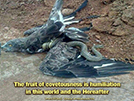Acceptance of Unseen Existence Involves Other Realities Besides God
- Details
- Hits: 4434
Chapter Two B
Acceptance of Unseen Existence Involves Other Realities Besides God
--------------------------------------------------------------------------------
The One God, Whom prophets and saints have led us to know, is absolute, imperceptible, eternal, transcendent, and omnipresent yet in no single place. He is imperceptible not only to the eyes but to all the sense-organs.
The human mind naturally finds the concept of a Being beyond all sense, matter, material expression, scientific test, or ordinary observation, not easy to entertain. People tend to lightly discard what they find to be difficult to conceive.
Atheists and humanists ask: "If God exists, why doesn't He show Himself?"
The Sciences, when they cannot get at a truth or express a fact in the formulae and measures proper to their realm; cannot deny its existence or prove its non-existence, at least until a test is devised which will demonstrate its impossibility and unfeasibility; they must pro tempore put it in their "awaiting solution" tray.
Do all the things which we accept, of whose existence we are convinced, owe our acknowledgement to our own existence or acquaintance or perception of them? Is it a proof of God's non-existence that He cannot be sensed physically and His qualities cannot be discerned corporeally? All materialists know that a great many of the teachings we hold firmly, derive their compulsion from judgement and facts that are neither perceptible by sense nor familiar. On the stage of being, there are innumerable invisible objects. Advances of modern science and knowledge have discovered myriads of such facts from infinite distances to infinitesimal hadrons and quarks.
One problem which is preoccupying scientists today is the change of mass into energy and vice versa. All visible bodies transfer energy to each other with a change in their own appearance, like the burning of wood. There is a transfer of energy. But this energy, which is the pivot for the vast majority of actions and consequences in the orderliness of the universe - how are we to assess it by sight or by touch?
Electricity plays an enormous part in all the constructions of science, culture, and ordinary living. But has any physicist - or anyone else for that matter - in experiments or in daily work with electrical appliances ever seen electricity itself? Has he felt or perceived by any other sense the weight, the texture, or construction of electricity? It is the lighting of a lamp or the observed effect of some other test which tells us that electricity works.
Until the work of Isaac Newton no one knew anything about the mutual attraction of bodies which Newton expressed in his equations of gravitation. Gravitation cannot be seen, makes no sound, cannot be felt, tasted, or smelt. But since Newton, the laws of gravity have been part of the basic concepts with which science calculates. All our new industries make use of it. Yet Newton himself never saw the force which he quantified so ably. It was observing the fortuitous fall of an apple from a tree that drew his attention to it.
Physicists make great use of spectroscopy. They reckon the colours of the spectrum as ranging from red at the bottom to violet at the top. But they also acknowledge that innumerable colours exist both below red and above violet, all imperceptible to us. Colour varies with wave-length, they tell us. And the wave-lengths are waves of light. The sun's light, or light from any other source, is composed of the combination of all the colours in a single ray, and 'white' in particular is the impression that the mix generally makes upon our optics. When these rays strike an object, that object absorbs a proportion of the rays and reflects back the rest. It is the reflected rays we see and by them we observe the object.
Moreover, colours change and differ in proportion to the weakness or strength of the wave. If the force of the wavelength reaches 457,000 milliards per second, the light moves into the red band; at 727 thousand milliards, into the violet band; while there are uncountable hues, shades, and saturations of colour and tint both above and below these figures which are beyond human perception.
The air which surrounds us has an extraordinary weight of its own. Its pressure on our bodies is a steady 16,000 kilograms. Because the pressures outside and inside the body are equal, we fell no discomfort. Before the days of Galileo Galilei (1564-1642) and Bliaise Pascal (1623-1662) this scientific fact was unknown. Nor could it ever have been recognised from the sense. Certain observed phenomena, like the variation in air pressure at different altitudes, drove thinkers to devise a hypothesis of the weight of air and then to devise experiments to test and prove it. [Our 4th Imam 'Ali Zaynu 'l-Abidin as-Sajjad in the 55th Litany of Vol. 2 of his works nonetheless adumbrated the concept in the antiphons of the section:
"Holy and Transcendent art Thou, our Creator and Preserver:
Thou knowest the weight of heaven.
"Holy and Transcendent art Thou, our Creator and Preserver:
Thou knowest the weight of the worlds.
"Holy and Transcendent art Thou, our Creator and Preserver:
Thou knowest the weight of the sun and the moon.
"Holy and Transcendent art Thou, our Creator and Preserver:
Thou knowest the weight of darkness and light.
"Holy and Transcendent art Thou, our Creator and Preserver:
Thou knowest the weights of air and of shadow."]
Even the natural qualities which scientists deduce on the basis of experiments which the senses can grasp, and the inferences ratiocination draws therefrom, cannot be directly perceived. Radiowaves are in movement in all directions, everywhere, all the time, yet not seen. No place is free of the forces of gravitational attraction, yet the force is not material nor can particles of it be found for measurement.
The task and triumph of science is the study of the effects of invisible forces and the formulation of their inner laws of being and operation.
Geology traces the formation of the strata in the earth's crust. With absolute certainty they inform us of the order of their formation over millions of years; and from their clines and anti-clines, their folds and outcroppings; tell us how the oceans came into being, how they spread, how the mountain chains were formed, how the continental plates have moved into their present positions. Yet no person now alive was there to witness any of these events about which they so confidently instruct us. And we believe them, without ourselves having seen any of it.
Metaphysical concepts like beauty or love, hate and enmity, and knowledge possess a form of existence which cannot be perceived nor its nature determined nor its limits fixed. Yet we nonetheless recognise them as realities. A man is conscious of knowing, and of what he knows, and of his perceptions of truths which cannot be felt by the senses. Man is also conscious of himself within his person, though no other human can observe that self. It is only observation of actions which enables us to deduce that a personal will inspires them.
Does the intangibility of these factors and the inscrutability of their qualities necessarily involve a denial of their existence? Atheists imagine that the existence of God must involve His occupying bodily space and time. They think that unless He possesses a set of limbs like themselves, His existence cannot be accepted. But these are the concepts of idolaters who set up temples with images. Since the eye of their mind and their reason is blind, they conclude that if a god exists, that deity must enjoy the same sort of existence as themselves, always within visual range. Further, since they feel that the most certain and accurate of their perceptions are those of the senses, they limit themselves to these, forgetting that problems of science and philosophy cannot be solved solely upon perception by the senses. Such a concept can only be misleading. Sense-perceptions alone cannot encompass the whole range of realities and of facts as they are made clear to us. The very eye which is our means of achieving certainty about some realities, is quite incapable of displaying other realities. Books of psychology have revealed a great deal to us on the subject of errors of sense-perception and have drawn our attention to a varied series of errors which the eye makes. They show us, in a kaleidoscope, moving pictures with waves of beauty and many changes, none of which has any independent reality but is due to the inbuilt errors of sight. Similarly, cinematographic films would not present a continuous picture to us were it not that the eye fails to distinguish the innumerable separate frames from each other, but sees them as one continuous picture in movement.
The fallibility of the tactile sense is easily proved by a simple experiment: Take 3 large pitchers. Fill the first with near-boiling water. Fill the second with room-temperature water. Fill the third with near-freezing water.
Plunge one hand into the hot and the other into the very cold water. Hold them there for a time. Take both hands out together and plunge both simultaneously into the second vessel of room-temperature water.
To your amazement, you experience two contradictory feelings at one and the same time. The hand taken out of the hot water informs your brain that the room-temperature water is cold. The hand taken out of the cold water informs you that the second vessel contains water all of one temperature – and that average – neither very hot nor very cold.
Logic, too, belies the information your hands give your brain. The water in one vessel can only have one temperature. The verdict of your hands is conditioned by their previous situation. Your mind contradicts them and says otherwise.
Thus mind must exercise control in assessing verdicts of the senses. What other guidelines are there?
Thus the five senses have no realistic and objective value, however great their practical use may be. People who rely solely on the senses for their information will never succeed in solving the problems of existence or the mystery of creation. Camille Flammarion in the book, Secrets of Death, writes:
"Mankind passes its life in ignorance and unknowing, not realising that the human physical make-up cannot lead a person to realities or that the five senses mislead him at every point. The only instruments which can lead man to realities are reason, thought, and precision."
Modern science and reasoning gives us certain proof that there exists such matter as molecules and atoms and forces which are invisible and imperceptible to any of the five senses. This affirmation opens the universe around us to the possibility that much else exists which is beyond our senses. We cannot deny existence of things we have not felt. For failure of the senses to perceive their existence is no scientific proof that they are not there. Our outward senses do not have the power to perceive everything which exists; indeed, they sometimes deceive us and show us the opposite of what is true. We must not imagine that all the truth of existence is restricted to what our senses can perceive. Indeed we must asseverate the opposite and acknowledge the possibility that matter exists which we can never sense. Just as, before the discovery of bacteria, no one ever imagined that millions upon millions exist within and around our bodies, or that everyone's life is the scene of battles between bacteria.
We therefore conclude that our outward sense does not have the power to display the reality and the truth of existence to us, and that it is reason and thought alone which can acquaint us accurately with the precise truth of the make-up of the universe we live in.











